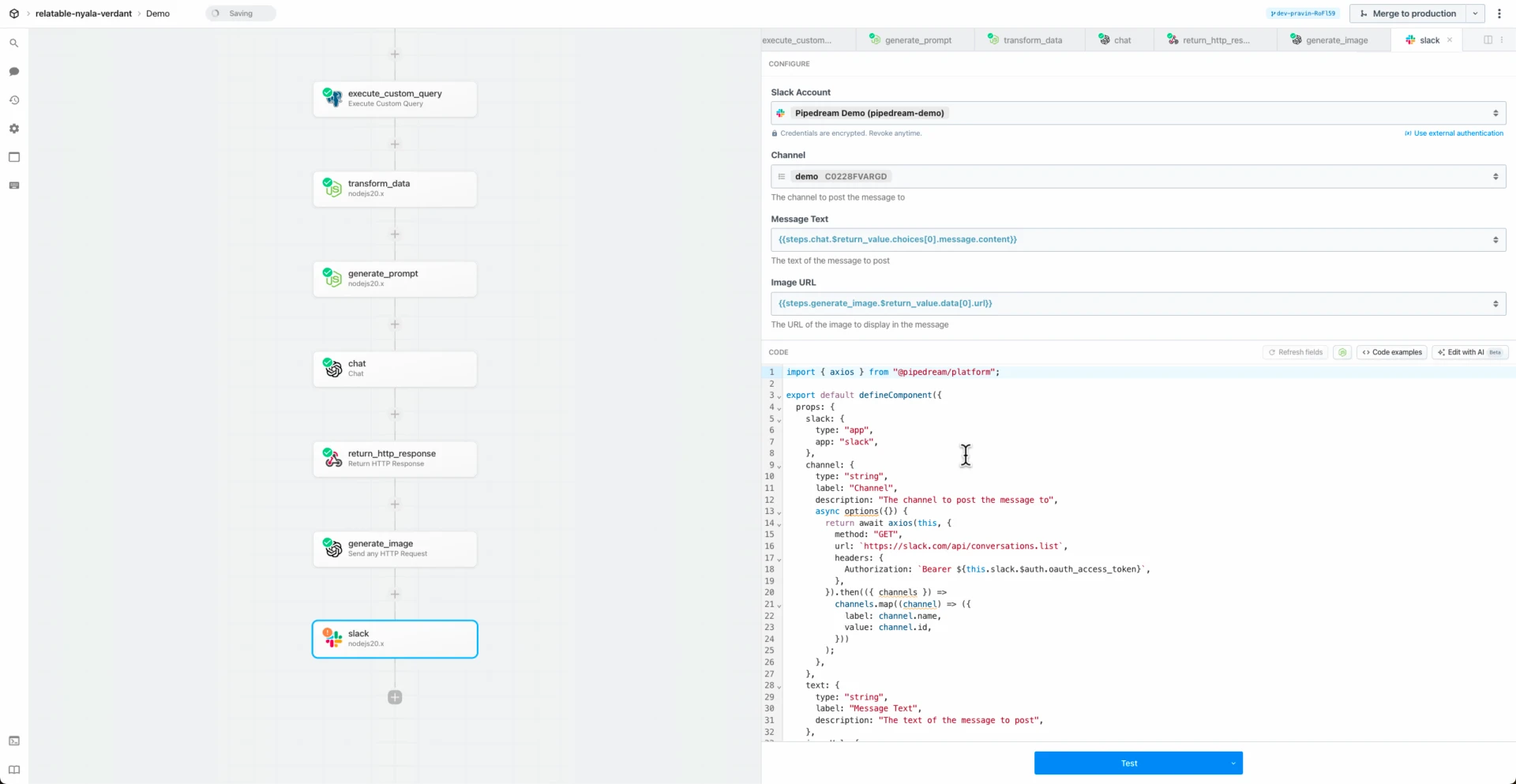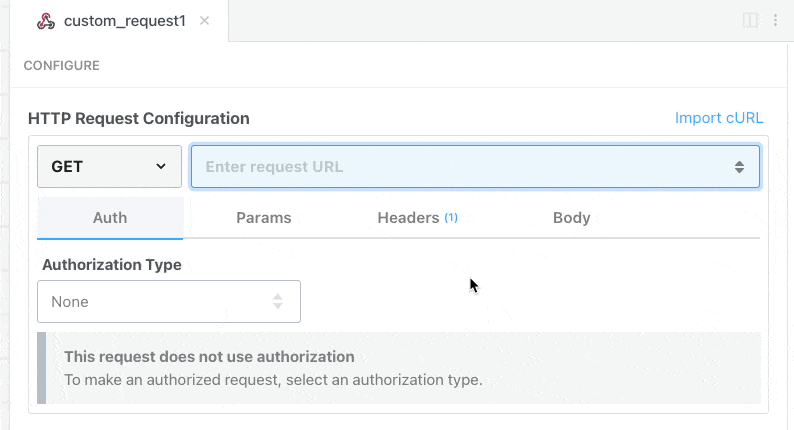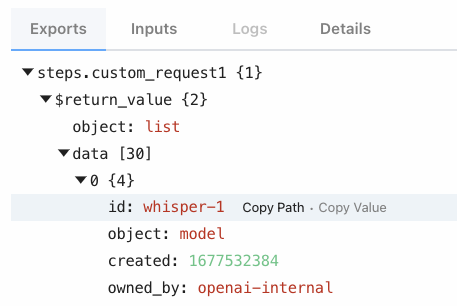import {
BACKGROUND_SOUND,
CLIENT_MESSAGE_OPTIONS,
FIRST_MESSAGE_MODE_OPTIONS,
SERVER_MESSAGE_OPTIONS,
} from "../../common/constants.mjs";
import {
clearObj,
parseObject,
} from "../../common/utils.mjs";
import vapi from "../../vapi.app.mjs";
export default {
key: "vapi-update-assistant-settings",
name: "Update Assistant Settings",
description: "Updates the configuration settings for a specific assistant. [See the documentation](https://docs.vapi.ai/api-reference/assistants/update)",
version: "0.0.2",
annotations: {
destructiveHint: true,
openWorldHint: true,
readOnlyHint: false,
},
type: "action",
props: {
vapi,
assistantId: {
propDefinition: [
vapi,
"assistantId",
],
},
transcriber: {
type: "object",
label: "Transcriber",
description: "A formatted JSON object for the assistant's transcriber. **Example: { \"provider\": \"talkscriber\", \"language\": \"en\", \"model\": \"whisper\" }**. [See the documentation](https://docs.vapi.ai/api-reference/assistants/update) for further details",
optional: true,
},
model: {
type: "object",
label: "Model",
description: "A formatted JSON object for the assistant's LLM. **Example: {\"provider\": \"xai\", \"model\": \"grok-beta\", \"emotionRecognitionEnabled\": true, \"knowledgeBase\": {\"server\": {\"url\": \"url\", \"timeoutSeconds\": 20}}, \"knowledgeBaseId\": \"model\", \"maxTokens\": 1.1, \"messages\": [{\"role\": \"assistant\"}], \"numFastTurns\": 1.1, \"temperature\": 1.1, \"toolIds\": [\"model\"], \"tools\": [{\"type\": \"transferCall\", \"async\": false}]}**. [See the documentation](https://docs.vapi.ai/api-reference/assistants/update) for further details",
optional: true,
},
voice: {
type: "object",
label: "Voice",
description: "A formatted JSON object for the assistant's voice. **Example: {\"provider\":\"tavus\",\"voiceId\":\"r52da2535a\",\"callbackUrl\":\"voice\",\"chunkPlan\":{\"enabled\":true,\"minCharacters\":30,\"punctuationBoundaries\":[\"。\",\",\",\".\",\"!\",\"?\",\";\",\"،\",\",\",\"।\",\"॥\",\"|\",\"||\",\",\",\":\"],\"formatPlan\":{\"enabled\":true,\"numberToDigitsCutoff\":2025}},\"conversationName\":\"voice\",\"conversationalContext\":\"voice\",\"customGreeting\":\"voice\",\"fallbackPlan\":{\"voices\":[{\"provider\":\"tavus\",\"voiceId\":\"r52da2535a\"}]},\"personaId\":\"voice\",\"properties\":{\"maxCallDuration\":1.1,\"participantLeftTimeout\":1.1,\"participantAbsentTimeout\":1.1,\"enableRecording\":true,\"enableTranscription\":true,\"applyGreenscreen\":true,\"language\":\"language\",\"recordingS3BucketName\":\"recordingS3BucketName\",\"recordingS3BucketRegion\":\"recordingS3BucketRegion\",\"awsAssumeRoleArn\":\"awsAssumeRoleArn\"}}**. [See the documentation](https://docs.vapi.ai/api-reference/assistants/update) for further details",
optional: true,
},
firstMessage: {
type: "string",
label: "First Message",
description: "The first message the assistant will say or a URL to an audio file. If unspecified, assistant will wait for user to speak and use the model to respond once they speak.",
optional: true,
},
firstMessageMode: {
type: "string",
label: "First Message Mode",
description: "Mode for the first message",
optional: true,
options: FIRST_MESSAGE_MODE_OPTIONS,
},
hipaaEnabled: {
type: "boolean",
label: "HIPAA Enabled",
description: "When this is enabled, no logs, recordings, or transcriptions will be stored. At the end of the call, you will still receive an end-of-call-report message to store on your server.",
optional: true,
},
clientMessages: {
type: "string[]",
label: "Client Messages",
description: "These are the messages that will be sent to your Client SDKs",
options: CLIENT_MESSAGE_OPTIONS,
optional: true,
},
serverMessages: {
type: "string[]",
label: "Server Messages",
description: "These are the messages that will be sent to your Server URL",
options: SERVER_MESSAGE_OPTIONS,
optional: true,
},
silenceTimeoutSeconds: {
type: "integer",
label: "Silence Timeout Seconds",
description: "How many seconds of silence to wait before ending the call.",
optional: true,
default: 30,
min: 10,
max: 3600,
},
maxDurationSeconds: {
type: "integer",
label: "Max Duration Seconds",
description: "This is the maximum number of seconds that the call will last. When the call reaches this duration, it will be ended.",
optional: true,
default: 600,
min: 10,
max: 43200,
},
backgroundSound: {
type: "string",
label: "Background Sound",
description: "This is the background sound in the call. Default for phone calls is 'office' and default for web calls is 'off'.",
optional: true,
options: BACKGROUND_SOUND,
},
backgroundDenoisingEnabled: {
type: "boolean",
label: "Background Denoising Enabled",
description: "This enables filtering of noise and background speech while the user is talking. Default false while in beta.",
optional: true,
},
modelOutputInMessagesEnabled: {
type: "boolean",
label: "Model Output in Messages Enabled",
description: "This determines whether the model's output is used in conversation history rather than the transcription of assistant's speech. Default false while in beta.",
optional: true,
},
transportConfigurations: {
type: "string[]",
label: "Transport Configurations",
description: "These are the configurations to be passed to the transport providers of assistant's calls, like Twilio. You can store multiple configurations for different transport providers. For a call, only the configuration matching the call transport provider is used. **Example: [{\"provider\":\"twilio\",\"timeout\":60,\"record\":false,\"recordingChannels\":\"mono\"}]**. [See the documentation](https://docs.vapi.ai/api-reference/assistants/update) for further details",
optional: true,
},
credentials: {
type: "string[]",
label: "Credentials",
description: "These are dynamic credentials that will be used for the assistant calls. By default, all the credentials are available for use in the call but you can supplement an additional credentials using this. Dynamic credentials override existing credentials. **Example: [{\"provider\":\"xai\",\"apiKey\":\"credentials\",\"name\":\"credentials\"}]**. [See the documentation](https://docs.vapi.ai/api-reference/assistants/update) for further details",
optional: true,
},
name: {
type: "string",
label: "Name",
description: "Name of the assistant. This is required when you want to transfer between assistants in a call.",
optional: true,
},
voicemailDetection: {
type: "object",
label: "Voicemail Detection",
description: "These are the settings to configure or disable voicemail detection. Alternatively, voicemail detection can be configured using the model.tools=[VoicemailTool]. This uses Twilio's built-in detection while the VoicemailTool relies on the model to detect if a voicemail was reached. You can use neither of them, one of them, or both of them. By default, Twilio built-in detection is enabled while VoicemailTool is not. **Example: {\"provider\":\"twilio\",\"voicemailDetectionTypes\":[\"machine_end_beep\",\"machine_end_silence\"],\"enabled\":true,\"machineDetectionTimeout\":1.1,\"machineDetectionSpeechThreshold\":1.1,\"machineDetectionSpeechEndThreshold\":1.1,\"machineDetectionSilenceTimeout\":1.1}**. [See the documentation](https://docs.vapi.ai/api-reference/assistants/update) for further details",
optional: true,
},
voicemailMessage: {
type: "string",
label: "Voicemail Message",
description: "This is the message that the assistant will say if the call is forwarded to voicemail. If unspecified, it will hang up",
optional: true,
},
endCallMessage: {
type: "string",
label: "End Call Message",
description: "This is the message that the assistant will say if it ends the call. If unspecified, it will hang up without saying anything",
optional: true,
},
endCallPhrases: {
type: "string[]",
label: "End Call Phrases",
description: "A list containing phrases that, if spoken by the assistant, will trigger the call to be hung up. Case insensitive.",
optional: true,
},
metadata: {
type: "object",
label: "Metadata",
description: "This is for metadata you want to store on the assistant.",
optional: true,
},
analysisPlan: {
type: "object",
label: "Analysis Plan",
description: "This is the plan for analysis of assistant's calls. Stored in `call.analysis`. **Example: {\"summaryPlan\":{\"messages\":[{\"key\":\"value\"}],\"enabled\":true,\"timeoutSeconds\":1.1},\"structuredDataPlan\":{\"messages\":[{\"key\":\"value\"}],\"enabled\":true,\"schema\":{\"type\":\"string\"},\"timeoutSeconds\":1.1},\"successEvaluationPlan\":{\"rubric\":\"NumericScale\",\"messages\":[{\"key\":\"value\"}],\"enabled\":true,\"timeoutSeconds\":1.1}}**. [See the documentation](https://docs.vapi.ai/api-reference/assistants/update) for further details",
optional: true,
},
artifactPlan: {
type: "object",
label: "Artifact Plan",
description: "This is the plan for artifacts generated during assistant's calls. Stored in call.artifact. **Note:** `recordingEnabled` is currently at the root level. It will be moved to `artifactPlan` in the future, but will remain backwards compatible. **Example: {\"recordingEnabled\":true,\"videoRecordingEnabled\":false,\"transcriptPlan\":{\"enabled\":true,\"assistantName\":\"assistantName\",\"userName\":\"userName\"},\"recordingPath\":\"recordingPath\"}**. [See the documentation](https://docs.vapi.ai/api-reference/assistants/update) for further details",
optional: true,
},
messagePlan: {
type: "object",
label: "Message Plan",
description: "This is the plan for static predefined messages that can be spoken by the assistant during the call, like idleMessages. **Note:** `firstMessage`, `voicemailMessage`, and `endCallMessage` are currently at the root level. They will be moved to `messagePlan` in the future, but will remain backwards compatible. **Example: {\"idleMessages\":[\"idleMessages\"],\"idleMessageMaxSpokenCount\":1.1,\"idleTimeoutSeconds\":1.1}**. [See the documentation](https://docs.vapi.ai/api-reference/assistants/update) for further details",
optional: true,
},
startSpeakingPlan: {
type: "object",
label: "Start Speaking Plan",
description: "This is the plan for when the assistant should start talking. **Example: {\"waitSeconds\":0.4,\"smartEndpointingEnabled\":false,\"customEndpointingRules\":[{\"type\":\"both\",\"assistantRegex\":\"customEndpointingRules\",\"customerRegex\":\"customEndpointingRules\",\"timeoutSeconds\":1.1}],\"transcriptionEndpointingPlan\":{\"onPunctuationSeconds\":0.1,\"onNoPunctuationSeconds\":1.5,\"onNumberSeconds\":0.5}}**. [See the documentation](https://docs.vapi.ai/api-reference/assistants/update) for further details",
optional: true,
},
stopSpeakingPlan: {
type: "object",
label: "Stop Speaking Plan",
description: "This is the plan for when assistant should stop talking on customer interruption. **Example: {\"numWords\":0,\"voiceSeconds\":0.2,\"backoffSeconds\":1}**. [See the documentation](https://docs.vapi.ai/api-reference/assistants/update) for further details",
optional: true,
},
monitorPlan: {
type: "object",
label: "Monitor Plan",
description: "This is the plan for real-time monitoring of the assistant's calls. **Note:** `serverMessages`, `clientMessages`, `serverUrl` and `serverUrlSecret` are currently at the root level but will be moved to `monitorPlan` in the future. Will remain backwards compatible. **Example: {\"listenEnabled\":false,\"controlEnabled\":false}**. [See the documentation](https://docs.vapi.ai/api-reference/assistants/update) for further details",
optional: true,
},
credentialIds: {
type: "string[]",
label: "Credential IDs",
description: "These are the credentials that will be used for the assistant calls. By default, all the credentials are available for use in the call but you can provide a subset using this.",
optional: true,
},
server: {
type: "object",
label: "Server",
description: "This is where Vapi will send webhooks. You can find all webhooks available along with their shape in ServerMessage schema. **Example: {\"url\":\"url\",\"timeoutSeconds\":20,\"secret\":\"secret\",\"headers\":{\"key\":\"value\"}}**. [See the documentation](https://docs.vapi.ai/api-reference/assistants/update) for further details",
optional: true,
},
},
async run({ $ }) {
const {
vapi,
assistantId,
transcriber,
model,
voice,
clientMessages,
serverMessages,
transportConfigurations,
credentials,
voicemailDetection,
endCallPhrases,
metadata,
analysisPlan,
artifactPlan,
messagePlan,
startSpeakingPlan,
stopSpeakingPlan,
monitorPlan,
credentialIds,
server,
...data
} = this;
const response = await vapi.updateAssistant({
$,
assistantId,
data: clearObj({
...data,
transcriber: parseObject(transcriber),
model: parseObject(model),
voice: parseObject(voice),
clientMessages: parseObject(clientMessages),
serverMessages: parseObject(serverMessages),
transportConfigurations: parseObject(transportConfigurations),
credentials: parseObject(credentials),
voicemailDetection: parseObject(voicemailDetection),
endCallPhrases: parseObject(endCallPhrases),
metadata: parseObject(metadata),
analysisPlan: parseObject(analysisPlan),
artifactPlan: parseObject(artifactPlan),
messagePlan: parseObject(messagePlan),
startSpeakingPlan: parseObject(startSpeakingPlan),
stopSpeakingPlan: parseObject(stopSpeakingPlan),
monitorPlan: parseObject(monitorPlan),
credentialIds: parseObject(credentialIds),
server: parseObject(server),
}),
});
$.export("$summary", `Updated assistant ${this.assistantId} successfully`);
return response;
},
};
 Chase Roberts@chsrbrts@benedictevans If you haven’t used @pipedream yet, then you haven’t lived.
Chase Roberts@chsrbrts@benedictevans If you haven’t used @pipedream yet, then you haven’t lived. ✨Ellie Day✨@heyelliedayEvaluation update: @pipedream has quite literally been a dream to work with! I’m excited to leverage this tool for all the various workflows I need to write. I’m currently at 11k invocations a day from the initial workflows I’ve written in the past couple weeks.
✨Ellie Day✨@heyelliedayEvaluation update: @pipedream has quite literally been a dream to work with! I’m excited to leverage this tool for all the various workflows I need to write. I’m currently at 11k invocations a day from the initial workflows I’ve written in the past couple weeks. Michael Braedley@MBraedleyUpdate: I got it working properly, and it's working so well that I'm dropping IFTTT. @pipedream can do everything that IFTTT basic can, and most (if not all things) IFTTT pro can for free or at a reasonable price if you need it. I am recommending it for basically any power user.
Michael Braedley@MBraedleyUpdate: I got it working properly, and it's working so well that I'm dropping IFTTT. @pipedream can do everything that IFTTT basic can, and most (if not all things) IFTTT pro can for free or at a reasonable price if you need it. I am recommending it for basically any power user. Thomas Cutting@mrthomascuttingWant quick+dirty integrations for a serverless workflow - @pipedream is my new go-to 😃
Thomas Cutting@mrthomascuttingWant quick+dirty integrations for a serverless workflow - @pipedream is my new go-to 😃 Matthew Roberts@mattdotrobertsday 013 - finally hit node js. This is the secret sauce of taking #nocode projects that one step further. Pumped about getting deeper into @pipedream now
Matthew Roberts@mattdotrobertsday 013 - finally hit node js. This is the secret sauce of taking #nocode projects that one step further. Pumped about getting deeper into @pipedream now Kenneth Auchenberg 💭@auchenbergYahoo Pipes is back! Kinda 😍 @pipedream
Kenneth Auchenberg 💭@auchenbergYahoo Pipes is back! Kinda 😍 @pipedream Raymond Camden 🥑@raymondcamdenAwesome video by the @pipedream folks showing real time twitter sentiment analysis integrated with Google Sheets. This is where Pipedream *really* shines, connecting systems together in easy workflows.
Raymond Camden 🥑@raymondcamdenAwesome video by the @pipedream folks showing real time twitter sentiment analysis integrated with Google Sheets. This is where Pipedream *really* shines, connecting systems together in easy workflows. Nacho Caballero@nachocaballeroI couldn't recommend @pipedream more. It's an amazing service to integrate different APIs. Much more powerful than Zapier and more user-friendly than AWS Lambda. I'm very proud to wear this t-shirt #NoCode
Nacho Caballero@nachocaballeroI couldn't recommend @pipedream more. It's an amazing service to integrate different APIs. Much more powerful than Zapier and more user-friendly than AWS Lambda. I'm very proud to wear this t-shirt #NoCode Jason Snow@jyksnwDeveloped a working prototype environmental sensor IoT solution with @particle Photon, @pipedream, and @MongoDB with full graphing and alerting in less than a day! All amazing technology, will def. be exploring these more.
Jason Snow@jyksnwDeveloped a working prototype environmental sensor IoT solution with @particle Photon, @pipedream, and @MongoDB with full graphing and alerting in less than a day! All amazing technology, will def. be exploring these more. Steven Terrana@steven_terrana@burgwyn you've inspired me to finally set up my own blog. I'll make sure my first blog post explains the tech behind the setup. think @obsdmd + @GatsbyJS + @pipedream.
Steven Terrana@steven_terrana@burgwyn you've inspired me to finally set up my own blog. I'll make sure my first blog post explains the tech behind the setup. think @obsdmd + @GatsbyJS + @pipedream. 🚄 James Augeri, PhD@DotDotJamesWant to low-code your back end, need more horsepower than @Bubble / @KnackHQ, or just miss Yahoo! Pipes? Check out @PipeDream
🚄 James Augeri, PhD@DotDotJamesWant to low-code your back end, need more horsepower than @Bubble / @KnackHQ, or just miss Yahoo! Pipes? Check out @PipeDream Sébastien Chopin@AtinuxGitHub issues should be like @linear_app for maintainers. Looking forward more integrations with GH actions or tools like @pipedream 👀
Sébastien Chopin@AtinuxGitHub issues should be like @linear_app for maintainers. Looking forward more integrations with GH actions or tools like @pipedream 👀 Raul@raul_predescuIf you're a dev and not using @pipedream, you're missing out. Been using it for months, daily. FREE for devs. Plenty of integrations and good limits. Absolutely love it.
Raul@raul_predescuIf you're a dev and not using @pipedream, you're missing out. Been using it for months, daily. FREE for devs. Plenty of integrations and good limits. Absolutely love it. Bruno Skvorc@bitfallsSo @pipedream is pretty amazing. In 3 minutes I just made a flow which adds @rickastley's Never Gonna Give You Up to my @spotify playlist whenever a new pull request arrives in an old repo of mine.
Bruno Skvorc@bitfallsSo @pipedream is pretty amazing. In 3 minutes I just made a flow which adds @rickastley's Never Gonna Give You Up to my @spotify playlist whenever a new pull request arrives in an old repo of mine. Zach Lanich@ZachLanichUm, wow 🤯 @pipedream
Zach Lanich@ZachLanichUm, wow 🤯 @pipedream Steven Bell@bellontechI just used @pipedream to build a Shopify App. Wow, they make small backed tasks easy.
Steven Bell@bellontechI just used @pipedream to build a Shopify App. Wow, they make small backed tasks easy. Jay Hack 🎩🇺🇸@_jayhack_Very impressed with this bad boi - it reminds me of a @PalantirTech internal tool, but geared towards integrations instead of data analysis and far more customizable. Great expectations here 🚀🤩
Jay Hack 🎩🇺🇸@_jayhack_Very impressed with this bad boi - it reminds me of a @PalantirTech internal tool, but geared towards integrations instead of data analysis and far more customizable. Great expectations here 🚀🤩 Tree Sturgeon 🔥🚴♂️🌳@philsturgeonFor context this is day 2 of a really challenging and stupid migration from Notion to @airtable with disparate/missing data. It's going better than expected and thanks to @pipedream I don't have to bother the iOS dev to add W3W.
Tree Sturgeon 🔥🚴♂️🌳@philsturgeonFor context this is day 2 of a really challenging and stupid migration from Notion to @airtable with disparate/missing data. It's going better than expected and thanks to @pipedream I don't have to bother the iOS dev to add W3W.




